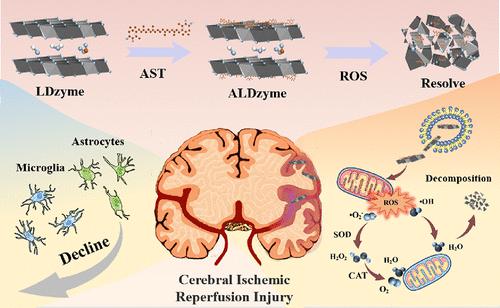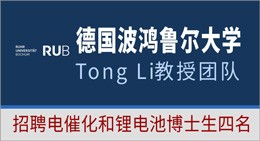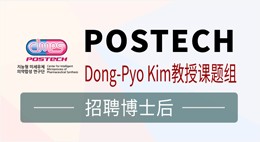当前位置:
X-MOL 学术
›
ACS Appl. Mater. Interfaces
›
论文详情
Our official English website, www.x-mol.net, welcomes your
feedback! (Note: you will need to create a separate account there.)
Unveiling the Mechanism of Alleviating Ischemia Reperfusion Injury via a Layered Double Hydroxide-Based Nanozyme
ACS Applied Materials & Interfaces ( IF 8.3 ) Pub Date : 2023-03-13 , DOI: 10.1021/acsami.2c19570
Xiaotong Ma 1, 2, 3 , Baorui Zhang 1 , Na Ma 3 , Chuxuan Liu 3 , Yan Miao 1 , Xin Liang 1 , Shanyue Guan 2 , Dawei Li 4 , Aihua Liu 1 , Shuyun Zhou 2
ACS Applied Materials & Interfaces ( IF 8.3 ) Pub Date : 2023-03-13 , DOI: 10.1021/acsami.2c19570
Xiaotong Ma 1, 2, 3 , Baorui Zhang 1 , Na Ma 3 , Chuxuan Liu 3 , Yan Miao 1 , Xin Liang 1 , Shanyue Guan 2 , Dawei Li 4 , Aihua Liu 1 , Shuyun Zhou 2
Affiliation

|
Oxidative stress after ischemia reperfusion can cause irreversible brain damage. Thus, it is vital to timely consume excessive reactive oxygen species (ROS) and conduct molecular imaging monitoring on the brain injury site. However, previous studies have focused on how to scavenge ROS while ignoring the mechanism of relieving the reperfusion injury. Herein, we reported a layered double hydroxide (LDH)-based nanozyme (denoted as ALDzyme), which was fabricated by the confinement of astaxanthin (AST) with LDH. This ALDzyme can mimic natural enzymes, which include superoxide dismutase (SOD) and catalase (CAT). Furthermore, the SOD-like activity of ALDzyme is 16.3 times higher than that of CeO2 (a typical ROS scavenger). Based on these enzyme-mimicking properties, this one-of-a-kind ALDzyme offers strong anti-oxidative properties as well as high biocompatibility. Importantly, this unique ALDzyme can establish an efficient magnetic resonance imaging platform, thus guiding the in vivo details. As a result, the infarct area can be reduced by 77% after reperfusion therapy, and the neurological impairment score can be lowered from 3–4 to 0–1. Density functional theory computations can reveal more about the mechanism of this ALDzyme’s significant ROS consumption. These findings provide a method for unraveling the neuroprotection application process in ischemia reperfusion injury using an LDH-based nanozyme as a remedial nanoplatform.
中文翻译:

揭示层状双羟基纳米酶减轻缺血再灌注损伤的机制
缺血再灌注后的氧化应激可导致不可逆的脑损伤。因此,及时消耗过量的活性氧(ROS)并对脑损伤部位进行分子影像学监测至关重要。然而,以往的研究主要集中在如何清除ROS,而忽略了减轻再灌注损伤的机制。在此,我们报道了一种基于层状双氢氧化物 (LDH) 的纳米酶(表示为 ALDzyme),它是通过用 LDH 限制虾青素 (AST) 制备的。这种 ALDzyme 可以模拟天然酶,包括超氧化物歧化酶 (SOD) 和过氧化氢酶 (CAT)。此外,ALDzyme 的类 SOD 活性是 CeO 2的 16.3 倍(典型的 ROS 清除剂)。基于这些酶模拟特性,这种独一无二的 ALDzyme 具有强大的抗氧化特性和高生物相容性。重要的是,这种独特的 ALDzyme 可以建立一个高效的磁共振成像平台,从而指导体内细节。结果,再灌注治疗后梗死面积可减少77%,神经损伤评分可从3-4分降至0-1分。密度泛函理论计算可以揭示更多关于这种 ALDzyme 大量 ROS 消耗的机制。这些发现提供了一种方法,可以使用基于 LDH 的纳米酶作为治疗性纳米平台来揭示缺血再灌注损伤中的神经保护应用过程。
更新日期:2023-03-13
中文翻译:

揭示层状双羟基纳米酶减轻缺血再灌注损伤的机制
缺血再灌注后的氧化应激可导致不可逆的脑损伤。因此,及时消耗过量的活性氧(ROS)并对脑损伤部位进行分子影像学监测至关重要。然而,以往的研究主要集中在如何清除ROS,而忽略了减轻再灌注损伤的机制。在此,我们报道了一种基于层状双氢氧化物 (LDH) 的纳米酶(表示为 ALDzyme),它是通过用 LDH 限制虾青素 (AST) 制备的。这种 ALDzyme 可以模拟天然酶,包括超氧化物歧化酶 (SOD) 和过氧化氢酶 (CAT)。此外,ALDzyme 的类 SOD 活性是 CeO 2的 16.3 倍(典型的 ROS 清除剂)。基于这些酶模拟特性,这种独一无二的 ALDzyme 具有强大的抗氧化特性和高生物相容性。重要的是,这种独特的 ALDzyme 可以建立一个高效的磁共振成像平台,从而指导体内细节。结果,再灌注治疗后梗死面积可减少77%,神经损伤评分可从3-4分降至0-1分。密度泛函理论计算可以揭示更多关于这种 ALDzyme 大量 ROS 消耗的机制。这些发现提供了一种方法,可以使用基于 LDH 的纳米酶作为治疗性纳米平台来揭示缺血再灌注损伤中的神经保护应用过程。

































 京公网安备 11010802027423号
京公网安备 11010802027423号